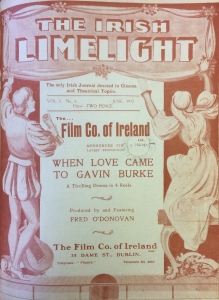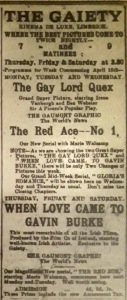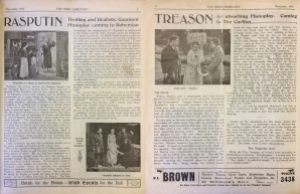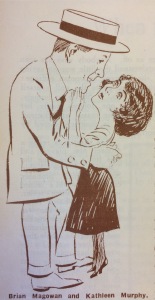Brian Magowan played a prominent role in When Love Came to Gavin Burke; Irish Limelight Dec. 1917: 6. Courtesy of the National Library of Ireland.
On 12 November 1917, the Freeman’s Journal announced that the Film Company of Ireland (FCOI) would “shortly reproduce a strong Irish drama, in six reels, entitled ‘When Love came to Gavin Burke.’” This article was part of the company’s increased publicity as it finally prepared to release the films it had shot that summer. The immediate occasion of the article was the release that day of Rafferty’s Rise, but it also mentioned the imminent appearance of three other FCOI films or film series: Knocknagow, which would open in Clonmel on 31 January 1918, “10,000 feet of Irish Scenery, showing mountain, river and town in all parts of the country,” and When Love Came to Gavin Burke. Probably because Knocknagow was such a priority, When Love Came to Gavin Burke seems to have been relatively neglected by FCOI, and the title does not show up in any newspaper searches for winter 1917.
Indeed, there are just a few mentions of Gavan Burke in Irish newspapers in 1918. “The idea of a single picture programme is a good one,” a reviewer in the Galway Expressobserved at the end of April 1918. “It obtained in the Town Hall with regard to ‘Knocknagow’ […], and ‘When Love Came to Gavin Burke’ is also a seven-part film that takes hours to screen.” Galway’s Town Hall was having a season of the work of FCOI, the epic Knocknagow having screened for the first three days of that week, When Love Came to Gavin Burke for the latter three and Rafferty’s Rise at the weekend. While Knocknagow and Rafferty’s Rise have been treated in some detail here already, When Love Came to Gavin Burke is in some ways a more obscure film, particularly in regards to when it was released and how widely it was shown in Ireland. It is also lost, like all FCOI’s feature films apart from Knocknagow, Willy Reilly and His Colleen Bawn (1920) and one reel of the two-reel comedy Paying the Rent (1920). This post will try to draw together some of the surviving information to try to establish when love actually came to Gavin Burke.
This Irish Limelight article from June 1916 refers to the shooting of When Love Came to Gavin Burke.
Some of these bits of information suggest that When Love Came to Gavin Burke was not so obscure in 1917-18. It was certainly well known to readers of the December 1917 issue of the Irish Limelight who could have read a detailed plot summary of the film. We’ll return to it shortly, but even more intriguingly, the only extant account of FCOI actually shooting a film on location undoubtedly refers to the production of Gavin Burke. This two page article in the June 1917 Limelight offers a unique glimpse of FCOI at work, with text by the Evening Telegraph’s critic JAP and four illustrations: a large photograph and three Frank Leah caricatures.
Beyond these two substantial articles, very few other details of the film’s production and exhibition are extant. Unsurprisingly then, the standard reference work on Irish cinema is a little vague on when exactly Gavin Burke was released. Kevin Rockett’s Irish Filmography and its online version put the film’s Irish premiere at an unspecified date in December 1917. This is plausible: it tallies with the Freeman’s Journal article, which implied that it would have its run before Knocknagow, stating that “[a]s soon as this drama [Gavin Burke] completes its run in Dublin they will be ready with their super-film, ‘Knocknagow’” (“Picture House Novelties”). It also corresponds with the publication of the film’s synopsis in the Limelight’s December 1917 issue.
Ad for what may be the first public screenings of “the most remarkable of all Irish films” at Limerick’s Gaiety, Limerick Chronicle 13 Apr. 1918: 3.
But no evidence appears to exist that it was actually shown in late 1917. Perhaps appropriately for a tale of love postponed, the film appears to have been held over until summer 1918. The first extant newspaper ads or notices related to screenings of the film date between April and December 1918 in Limerick (Gaiety: 18-20 April), Galway (Town Hall: 25-27 April), Dublin (Pillar: 24-26 June; Sandford: 23-25 September) and Derry (St Columb’s Hall: 19-21 December). On the available evidence, the run at Limerick’s Gaiety was when the public first saw the film. However, the Limerick press paid the film scant attention. Gavin Burke seems to have received little love from Limerick’s popular audience. This was also the case for the other venues; just the already discussed Galway notice provides anything beyond the barest details. Even the film’s length is not consistent between the surviving sources, with an ad on the cover of the June 1917 Limelight putting it at four reels, the Derry Journal mentioning “five acts,” the Freeman’s Journal calculating six reels, and the Galway Express estimating seven reels. That would put the running time of the film at anything between about 67 minutes for four reels and 120 for seven, assuming the unlikely scenario that the film was projected at a consistent or average 16 frames a second.
If the synopsis in the Limelight is anything to go by, the narrative included enough twists and turns to fill two hours. As a phenomenon, the extended narrative synopsis was an established genre of film trade journalism, and the Limelight carried a number of them in each issue. For example, the page before the Gavin Burke article carried a synopsis of Rasputin (US: World Brady, 1917) and the page after it offered a synopsis of Treason (US: Universal, 1917). What distinguished these films from Gavin Burke, apart from the fact that they were American productions, is that they had already been booked to play at one of Dublin’s major cinemas, and this was mentioned alongside the synopsis to publicize the upcoming run. FCOI appears to have had no bookings of Gavin Burke to publicize in December 1917.
These actresses played different stages of Grace’s life in When Love Came to Gavin Burke; Irish Limelight Dec. 1917: 7.
Fred O’Donovan directed and starred in Gavin Burke, supported by such familiar members of the FCOI stock company as Brian Magowan, Nora Clancy, Queenie Coleman and Valentine Roberts, as well as the less familiar Stephen Gould and the child actress Oonah Halpin. To synopsize the synopsis, the film is set on the banks of the Liffey in the late 19th century and tells the story of poor farmer Gavin Burke (O’Donovan) who becomes embittered when his sweetheart Kate (Clancy) rejects him for a comfortably off hotel owner (Gould). The hotel owner turns out to be a drunken wastrel who is accidentally killed while bringing their sick daughter Grace (Halpin) to the doctor, and the girl is taken in by Burke, who had parleyed his bitterness into material wealth but is nevertheless charmed by Grace. He makes a deal with Kate that he will raise Grace as his own daughter provided the now impoverished Kate never sees her again. Time passes and a mature Grace (Coleman) faces a similar choice to her mother but unlike Kate, chooses Jack Devine (Magowan), the poor man she loves, rather than Tom Ryan (Roberts), the man who seems to offer material comfort. Burke dispenses words of wisdom when the rivalry leads Ryan to unsuccessfully attempt to kill Devine, gives his wealth to Grace at her wedding, and has his offer of his love accepted by Kate despite the fact that he has voluntarily returned himself to the poverty of his younger days.
Two points seem noteworthy about the way the film negotiates familiar elements of the romance. The first is the way in which women are seemingly offered agency in their ability to make choices in their romantic relationships but that these choices are illusory because the choice of following one’s heart is always right. The second is the way in which the right choice is linked to a rejection of material comfort in favour of the frugal life of the small farmer. Neither of these points makes the film particularly Irish; indeed, Gavin Burke seems to owe as much to Emily Brontë’s Heathcliff as to the peasant plays of Dublin’s Abbey Theatre with which the director and cast were familiar. Again, it is to be expected that a romantic drama would raise issues of gender and class, but the lack of more information on the film’s exhibition hinders a more specific reading of it in relation to struggles over women’s role in Irish society and/or the ideological investment in an ascetic rural life.
Frank Leah’s caricature of Robert Justice operating the camera for Gavin Burke; Limelight Jun 1917: 10-11.
The paucity of exhibition details is disappointing, but JAP’s Limelight article on Gavin Burke does allow us to say something more about FCOI’s filmmaking procedures. It too, however, is written as a humorous account of a day’s motoring excursion with a group of friends rather than a more informative, if less entertaining, documenting of what he saw. Much of the humour is at the expense of the “Artist Person,” presumably Frank Leah, who provided the accompanying caricatures. The only member of the party named is “friend Haigh,” presumably photographer Charlie Haigh, who was the Irish manager for the Triangle Film Company and may have been responsible for the poorly reproduced photograph that accompanied the article. Leah’s caricatures are informative at least in indicating that Robert Justice was the cinematographer; other details of the production team are lacking, especially the identity of the scriptwriter. The actual filming location that JAP’s party drove to is not made clear; he reveals only that their journey ends “fifteen miles from everywhere” at as an old-fashioned house with an ancient summer house.
Leah’s caricature of a love scene between Brian Magowan and Kathleen Murphy; Limelight Jun 1917: 10.
In the summer house, he spies
Miss Kathleen Murphy, dark-haired, tragic-eyed, gazing fondly up into the honest open countenance of Brian Magowan, and […] the gallant youth gazing lovingly down into the star-like orbs of la petite brunette. Even as we interlopers looked upon the scene their faces approached together, their lips—
Apparently I was the only person present possessing the instincts of a gentlemen.
“We are intruding,” said I, “let us retire quickly and quietly before we are observed.”
But the Artist Person, with a coarse laugh, produced a section of millboard and a pencil, and proceeded to rapidly sketch the affecting tableau upon which we had stumbled so suddenly.
This, of course, turns out to be scene from the film FCOI are shooting, with Fred O’Donovan directing. “‘Place you hand upon her shoulder, Brian. Put your right hand on his shoulder, Miss Murphy. Now kiss – a good long one.’” This scene may not, however, be from Gavin Burke. Kathleen Murphy is not mentioned in the cast listing for the film in the Limelight synopsis, where Magowan’s Jack Devine should be romantically paired with Coleman’s mature Grace. As such, it may be from an unknown subplot of the film or from a different and unfinished film, which would be a shame because “[t]hey had to go through that touching scene three times before Fred O’Donovan was satisfied. I never saw a man with such particular notions about love-making.”
Other scenes he mentions seem to be more clearly from Gavin Burke. A “most realistic and lady-like dispute” between Nora Clancy and Queenie Coleman, does seem to match the casting of the film, where these women played Kate and her grown-up daughter, respectively. And a lengthy anecdote about Magowan and Valentine Grant being swept away by the Liffey as they filmed a fight scene throw light on how Grant’s Tom Ryan attempted to kill Magowan’s Devine. JAP finished on a more serious note, praising the progress FCOI had made in the bare year since the company was founded. “These Irish Players have completely got the hand of the business by now,” he contended. “When you consider that they practically had to teach themselves the business, the progress they have made is really marvellous.”
However, another year on as Gavin Burke was released in the summer of 1918, it was not at all certain as JAP claimed, that FCOI’s films “can compete with the very best films produced in Great Britain.” Even in its home market, Gavin Burke seems to have received very little love.
Denis Condon lectures in film at NUI Maynooth.
Contact: denis.j.condon@nuim.ie
References
JAP. “With the Film Co. of Ireland: A Day with the Producers.” Irish Limelight Jun. 1917: 10-11.
“Picture House Novelties: New Productions of Film Company of Ireland.” Freeman’s Journal 12 Nov. 1917: 4.
Rockett, Kevin. The Irish Filmography. Dublin: Red Mountain, 1996.
“When Love Came to Gavin Burke.” Irish Limelight Dec. 1917: 6-7.














